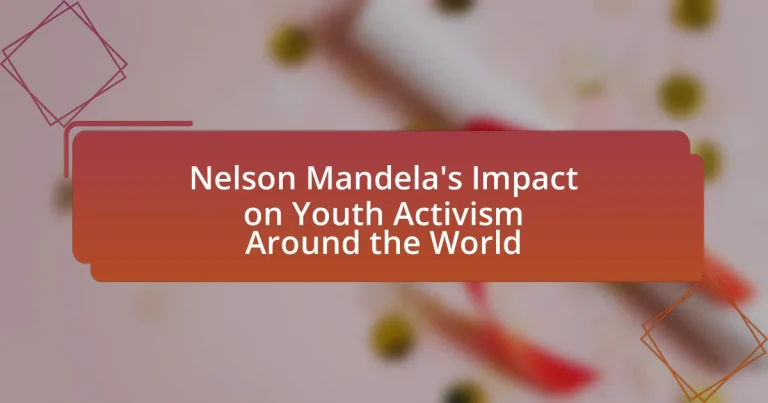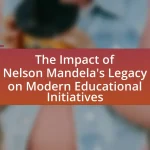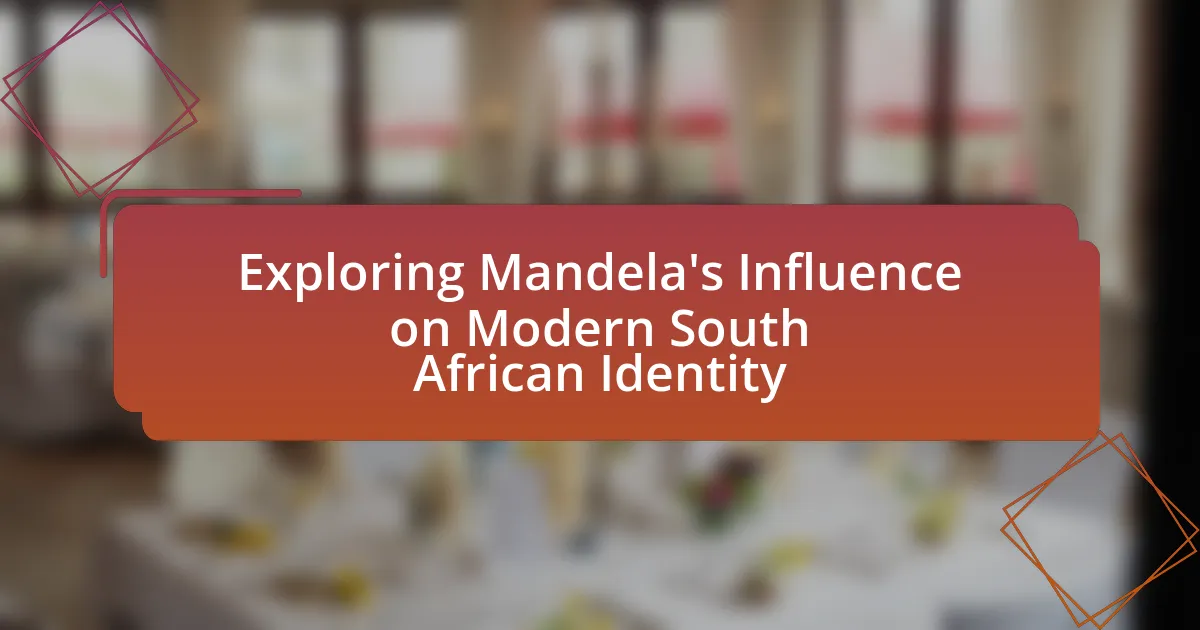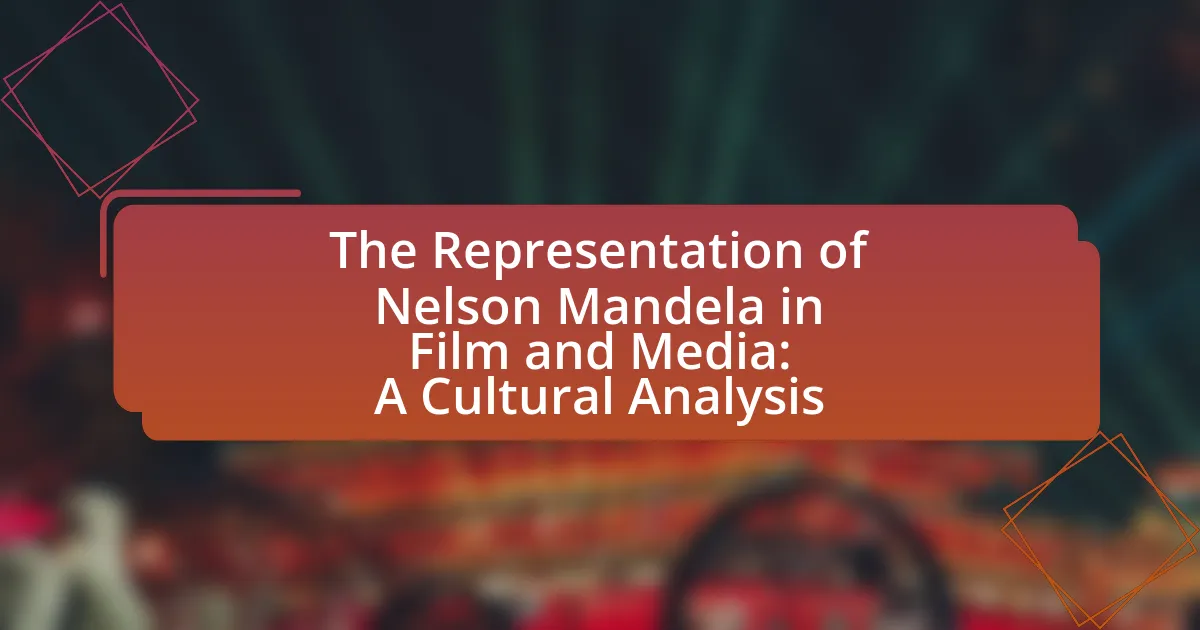Nelson Mandela’s impact on youth activism around the world is profound, as he inspired young leaders to advocate for social justice and equality through his commitment to fighting apartheid and promoting human rights. His leadership during key events, such as the Soweto Uprising, exemplified the power of collective action, motivating youth movements globally, including Black Lives Matter and climate activism. Mandela’s philosophy of resilience, education, and reconciliation continues to shape the beliefs and strategies of young activists today, encouraging them to engage in social justice initiatives and community service. His legacy serves as a guiding framework for youth-led movements addressing contemporary issues of inequality and human rights.
What is Nelson Mandela’s Impact on Youth Activism Around the World?
Nelson Mandela significantly influenced youth activism globally by inspiring young leaders to advocate for social justice and equality. His commitment to fighting apartheid and promoting human rights resonated with youth movements, encouraging them to challenge oppressive systems. For instance, Mandela’s leadership during the anti-apartheid struggle demonstrated the power of collective action, motivating young activists in various countries to engage in protests and campaigns for change. His legacy is evident in movements like Black Lives Matter and climate activism, where youth draw on his principles of resilience and justice to address contemporary issues. Mandela’s emphasis on education as a tool for empowerment further galvanized young people to pursue activism, as he famously stated, “Education is the most powerful weapon which you can use to change the world.” This belief has inspired countless youth initiatives focused on education and social reform worldwide.
How did Nelson Mandela inspire youth activism globally?
Nelson Mandela inspired youth activism globally by exemplifying resilience and the power of collective action against oppression. His leadership in the anti-apartheid movement demonstrated how young people could mobilize for social justice, as seen in the Soweto Uprising of 1976, where students protested against discriminatory education policies. Mandela’s emphasis on education, equality, and human rights resonated with youth worldwide, encouraging them to advocate for change in their own communities. His legacy is evident in various global youth movements, such as the fight against climate change and social inequality, where young activists cite Mandela’s principles of courage and perseverance as foundational to their efforts.
What key events in Mandela’s life influenced youth movements?
Key events in Nelson Mandela’s life that influenced youth movements include his involvement in the African National Congress (ANC) and the formation of the ANC Youth League in 1944, which aimed to mobilize young people against apartheid. Mandela’s leadership during the Defiance Campaign in 1952, where he encouraged mass protests against unjust laws, galvanized youth participation in activism. Additionally, his imprisonment from 1962 to 1990 became a symbol of resistance, inspiring global youth movements advocating for justice and equality. The Soweto Uprising in 1976, where students protested against the imposition of Afrikaans in schools, was directly influenced by Mandela’s legacy, as it highlighted the struggle against apartheid and motivated young people to engage in activism. These events collectively shaped the political consciousness of youth in South Africa and around the world, reinforcing the importance of activism in the fight for social justice.
How did Mandela’s philosophy shape the beliefs of young activists?
Mandela’s philosophy significantly shaped the beliefs of young activists by promoting principles of equality, justice, and non-violence. His emphasis on reconciliation and the importance of fighting against oppression inspired youth to engage in activism that sought to dismantle systemic injustices. For instance, Mandela’s leadership during the anti-apartheid movement demonstrated the power of collective action and peaceful protest, which motivated young activists globally to adopt similar strategies in their own struggles for rights and freedoms. His legacy is evident in movements such as Black Lives Matter, where the ideals of justice and equality continue to resonate with younger generations, reinforcing the belief that activism can lead to meaningful change.
Why is Nelson Mandela considered a symbol for youth activism?
Nelson Mandela is considered a symbol for youth activism due to his unwavering commitment to justice, equality, and human rights, which inspired generations of young people globally. His leadership in the anti-apartheid movement, particularly his ability to mobilize youth through organizations like the African National Congress Youth League, demonstrated the power of collective action. Mandela’s imprisonment for 27 years became a rallying point for youth activism, highlighting the struggle against oppression and the importance of resilience. His eventual release and presidency further solidified his role as a mentor and advocate for young leaders, emphasizing education and empowerment as essential tools for social change.
What qualities of Mandela resonate with young activists today?
Nelson Mandela’s qualities of resilience, leadership, and commitment to justice resonate strongly with young activists today. His resilience is exemplified by his 27 years of imprisonment, during which he maintained his vision for a free South Africa, inspiring youth to persevere in their own struggles against injustice. Mandela’s leadership style, characterized by inclusivity and collaboration, encourages young activists to unite diverse groups for common causes. Additionally, his unwavering commitment to social justice and equality serves as a powerful model for today’s youth, motivating them to advocate for human rights and systemic change globally. These qualities are reflected in contemporary movements, such as Black Lives Matter and climate activism, where young leaders draw inspiration from Mandela’s legacy to drive their initiatives.
How has Mandela’s legacy been utilized in youth-led movements?
Mandela’s legacy has been utilized in youth-led movements as a source of inspiration and a framework for advocating social justice and equality. His emphasis on resilience, forgiveness, and activism has motivated young leaders globally to address issues such as racial inequality, climate change, and human rights. For instance, organizations like the Mandela Institute for Humanity empower youth to engage in community service and activism, reflecting Mandela’s belief in the power of young people to effect change. Additionally, the annual Nelson Mandela International Day encourages youth to take action in their communities, reinforcing the idea that small acts of kindness can lead to significant societal impact.

What are the key movements influenced by Nelson Mandela?
Nelson Mandela significantly influenced key movements such as the anti-apartheid movement, global human rights advocacy, and youth activism for social justice. His leadership in the African National Congress (ANC) galvanized efforts against racial segregation in South Africa, culminating in the end of apartheid in 1994. Mandela’s emphasis on reconciliation and equality inspired youth movements worldwide, including the fight against systemic racism in the United States and the global climate justice movement. His legacy is evident in initiatives like the Nelson Mandela Foundation, which promotes social justice and youth empowerment, reinforcing his impact on activism across generations.
How did Mandela’s activism impact the anti-apartheid movement?
Mandela’s activism significantly advanced the anti-apartheid movement by mobilizing both national and international support against racial segregation in South Africa. His leadership in the African National Congress (ANC) and his role in organizing protests, such as the Defiance Campaign in 1944, galvanized public opinion and drew attention to the injustices of apartheid. Furthermore, Mandela’s imprisonment from 1962 to 1990 became a symbol of the struggle against oppression, inspiring global campaigns for his release and increasing pressure on the South African government. His eventual negotiation for a peaceful transition to democracy in the early 1990s culminated in the end of apartheid, demonstrating the effectiveness of his activism in achieving social and political change.
What role did youth play in the anti-apartheid struggle?
Youth played a pivotal role in the anti-apartheid struggle by mobilizing mass protests and advocating for change. Notably, the Soweto Uprising in 1976, where thousands of students protested against the imposition of Afrikaans as the medium of instruction, exemplified their impact; this event galvanized international attention and support for the anti-apartheid movement. The involvement of youth organizations, such as the South African Students’ Organization, further demonstrated their commitment to dismantling apartheid, as they organized rallies, strikes, and educational campaigns that challenged the oppressive regime.
How did Mandela’s release from prison affect youth activism in South Africa?
Mandela’s release from prison in 1990 significantly invigorated youth activism in South Africa. His liberation inspired a new generation of young activists who were motivated by his vision of equality and justice, leading to increased participation in anti-apartheid movements. The formation of organizations like the South African Students’ Organization and the African National Congress Youth League saw a surge in membership and activism, as youth rallied for political change and social justice. This period also marked the rise of protests and demonstrations, with young people playing a crucial role in mobilizing communities against the apartheid regime, ultimately contributing to the dismantling of apartheid in the early 1990s.
What global youth movements have drawn inspiration from Mandela?
Global youth movements that have drawn inspiration from Nelson Mandela include the Black Lives Matter movement, the March for Our Lives initiative, and various climate justice movements. These movements reflect Mandela’s principles of equality, justice, and activism against oppression. For instance, Black Lives Matter emphasizes racial equality and social justice, echoing Mandela’s fight against apartheid and systemic racism. Similarly, March for Our Lives advocates for gun control and youth empowerment, aligning with Mandela’s belief in the power of youth to effect change. Climate justice movements, such as Fridays for Future, also resonate with Mandela’s legacy by promoting global solidarity and responsibility for future generations.
How have international youth organizations honored Mandela’s legacy?
International youth organizations have honored Mandela’s legacy by promoting his values of equality, justice, and social activism through various initiatives. For instance, organizations like the African Union Youth Envoy and the United Nations Youth Programme have implemented programs that encourage young people to engage in community service and advocacy, reflecting Mandela’s commitment to social change. Additionally, the Nelson Mandela Foundation collaborates with youth organizations globally to facilitate educational programs that emphasize leadership and civic responsibility, ensuring that Mandela’s ideals continue to inspire future generations. These efforts are evident in initiatives such as the annual Nelson Mandela International Day, which mobilizes youth worldwide to participate in community service, thereby reinforcing Mandela’s vision of active citizenship and social responsibility.
What examples exist of youth-led initiatives inspired by Mandela’s teachings?
Youth-led initiatives inspired by Mandela’s teachings include the “Mandela Day” campaign, which encourages individuals to dedicate 67 minutes of their time to community service, reflecting Mandela’s 67 years of activism. Another example is the “Youth for Mandela” initiative, which empowers young people to engage in social justice and leadership activities, promoting values of equality and human rights. Additionally, the “Nelson Mandela Children’s Fund” supports youth development projects that align with Mandela’s vision for education and empowerment. These initiatives demonstrate the ongoing influence of Mandela’s legacy in inspiring youth activism globally.
How can youth today continue Mandela’s legacy in activism?
Youth today can continue Mandela’s legacy in activism by engaging in social justice movements that address inequality and human rights issues. They can draw inspiration from Mandela’s commitment to nonviolent resistance and grassroots organizing, which played a crucial role in dismantling apartheid in South Africa. For instance, the global youth-led climate movement exemplifies this approach, as young activists advocate for environmental justice and policy changes, echoing Mandela’s belief in the power of collective action. Additionally, youth can utilize digital platforms to raise awareness and mobilize support, reflecting Mandela’s understanding of the importance of communication in activism. By embodying these principles, today’s youth can honor Mandela’s legacy and contribute to meaningful change in their communities and beyond.
What strategies can young activists adopt from Mandela’s approach?
Young activists can adopt several strategies from Nelson Mandela’s approach, including the emphasis on reconciliation, the importance of education, and the power of grassroots mobilization. Mandela’s commitment to reconciliation after apartheid demonstrated that healing and unity can be more effective than revenge, encouraging activists to seek common ground and dialogue. His belief in education as a tool for empowerment highlights the necessity for young activists to educate themselves and their communities about social issues, fostering informed advocacy. Additionally, Mandela’s success in mobilizing grassroots support illustrates the effectiveness of community engagement and collective action, urging young activists to build strong networks and collaborate with local organizations to amplify their impact.
How can youth leverage social media for activism, inspired by Mandela?
Youth can leverage social media for activism by using it as a platform to raise awareness, mobilize support, and share their messages, inspired by Nelson Mandela’s commitment to justice and equality. Social media enables young activists to connect with a global audience, disseminate information rapidly, and organize events or campaigns effectively. For instance, the #FeesMustFall movement in South Africa utilized social media to challenge educational inequalities, echoing Mandela’s advocacy for accessible education. This demonstrates how social media can amplify voices and foster community engagement, aligning with Mandela’s legacy of empowering youth to drive social change.
What lessons can be learned from Mandela’s resilience in activism?
Mandela’s resilience in activism teaches the importance of perseverance, strategic patience, and the power of forgiveness. His 27 years of imprisonment exemplified unwavering commitment to justice, demonstrating that enduring hardship can lead to significant societal change. Mandela’s ability to forgive his oppressors, as seen in his leadership post-apartheid, highlights the necessity of reconciliation in healing divided communities. His approach emphasizes that effective activism requires not only a vision for change but also the strength to endure challenges and the wisdom to unite rather than divide.
What are the challenges faced by youth activists today?
Youth activists today face significant challenges, including political repression, lack of funding, and social media misinformation. Political repression manifests through government crackdowns on protests and dissent, limiting the ability of young activists to organize and express their views. A report by the International Youth Foundation highlights that 70% of youth activists experience barriers to funding, which restricts their capacity to implement projects and campaigns. Additionally, misinformation on social media complicates the dissemination of accurate information, leading to public confusion and undermining the credibility of youth-led movements. These challenges hinder the effectiveness and reach of youth activism globally.
How can young activists overcome obstacles in their movements?
Young activists can overcome obstacles in their movements by leveraging community support and utilizing digital platforms for organization and outreach. Community support provides a network of resources, mentorship, and solidarity, which can enhance resilience against challenges. For instance, the Black Lives Matter movement gained momentum through local community engagement and support, demonstrating the power of collective action. Additionally, digital platforms like social media enable young activists to mobilize quickly, share information, and connect with a global audience, as seen in the global youth climate strikes initiated by Greta Thunberg. These strategies empower young activists to navigate and dismantle barriers effectively.
What support systems are essential for youth activism in the modern world?
Essential support systems for youth activism in the modern world include access to education, mentorship programs, digital platforms for communication, and community engagement initiatives. Access to education equips young activists with knowledge about social issues and advocacy strategies, while mentorship programs provide guidance from experienced activists, enhancing their skills and confidence. Digital platforms, such as social media, facilitate the rapid dissemination of information and mobilization of support, as evidenced by movements like #BlackLivesMatter, which gained traction through online engagement. Community engagement initiatives foster local support networks, allowing youth to collaborate on projects and amplify their voices. These systems collectively empower youth to drive social change effectively.
What practical steps can youth take to engage in activism inspired by Mandela?
Youth can engage in activism inspired by Mandela by educating themselves on social justice issues and participating in community service initiatives. By understanding the principles of equality and human rights that Mandela championed, young people can raise awareness through social media campaigns and organize local events that promote dialogue and action. For instance, Mandela’s legacy emphasizes the importance of grassroots movements, so youth can form or join organizations that advocate for change, such as environmental groups or human rights organizations. Additionally, they can volunteer for political campaigns that align with their values, thereby influencing policy and leadership. Mandela’s own activism was rooted in collective action, demonstrating that youth can make a significant impact when they unite for a common cause.




